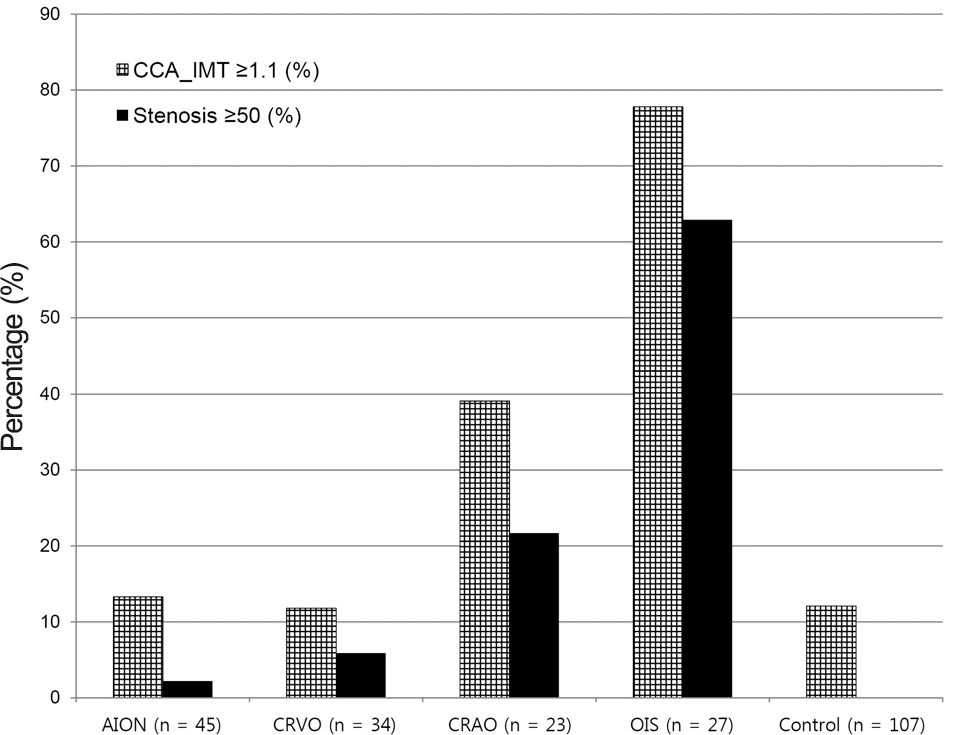1. Barnett HJ, Eliasaziw M, Meldrum HE. Drugs and surgery in the prevention of ischemic stroke. N Engl J Med. 1995; 332:238–48.

2. Suh DC, Lee SH, Kim KR. . Pattern of atherosclerotic carotid stenosis in Korean patients with stroke: different involvement of intracranial versus extracranial vessels. AJNR Am J Neuroradiol. 2003; 24:239–44.
3. Ferrières J, Elias A, Ruidavets JB. . Carotid intima-media thickness and coronary heart disease risk factors in a low-risk population. J Hypertens. 1999; 17:743–8.

4. O’Leary DH, Polak JF, Kronmal RA. . Carotid-artery intima and media thickness as a risk factor for myocardial infarction and stroke in older adults. Cardiovascular Health Study Collaborative Research Group. N Engl J Med. 1999; 340:14–22.
5. O’Leary DH, Polak JF, Kronmal RA. . Thickening of the car-otid wall. A marker for atherosclerosis in the elderly? Cardiovascular Health Study Collaborative Research Group. Stroke. 1996; 27:224–31.
6. Bullock JD, Falter RT, Downing JE, Snyder HE. Ischemic oph-thalmia secondary to an ophthalmic artery occlusion. Am J Ophthalmol. 1972; 74:486–93.
7. Stamler J, Wentworth D, Neaton JD. Is relationship between serum cholesterol and risk of premature death from coronary heart disease continuous and graded? Findings in 356,222 primary screenees of the Multiple Risk Factor Intervention Trial (MRFIT). JAMA. 1986; 256:2823–8.

8. National Cholesterol Education Program (NCEP) Expert Panel on Detection, Evaluation, and Treatment of High Blood Cholesterol in Adults (Adult Treatment Panel III). Third Report of the National Cholesterol Education Program (NCEP) Expert Panel on Detection, Evaluation, and Treatment of High Blood Cholesterol in Adults (Adult Treatment Panel III) final report. Circulation. 2002; 106:3143–421.
9. Liu J, Grundy SM, Wang W. . Ten-year risk of cardiovascular incidence related to diabetes, prediabetes, and the metabolic syndrome. Am Heart J. 2007; 153:552–8.

10. Handa N, Matsumoto M, Maeda H. . Ultrasonic evaluation ear-ly carotid atherosclerosis. Stroke. 1990; 21:1567–72.
11. Pignoli P, Tremoli E, Poli A. . Intimal plus medial thickness of the arterial wall: a direct measurement with ultrasound imaging. Circulation. 1986; 74:1399–406.

12. Grant EG, Benson CB, Moneta GL. . Carotid artery stenosis: gray-scale and Doppler US diagnosis-Society of Radiologists in Ultrasound Consensus Conference. Radiology. 2003; 229:340–6.

13. Kawasaki T, Koga N, Hikichi Y. . Diagnostic accuracy of car-otid ultrasonography in screening for coronary artery disease. J Cardiol. 2000; 36:295–302.
14. O’Leary DH, Polak JF, Kronmal RA. . Distribution and corre-lates of sonographically detected carotid artery disease in the Cardiovascular Health Study. The CHS Collaborative Research Group. Stroke. 1992; 23:1752–60.

15. Salonen JT, Salonen R. Ultrasound B-mode imaging in ob-servational studies of atherosclerotic progression. Circulation. 1993; 87((3 Suppl)):II56–65.
16. Nowak J, Nilsson T, Sylvén C, Jogestrand T. Potential of carotid ul-trasonography in the diagnosis of coronary artery disease: a com-parison with exercise test and variance ECG. Stroke. 1998; 29:439–46.
17. Kannel WB, McGee D, Gordon T. A general cardiovascular risk profile: the Framingham Study. Am J Cardiol. 1976; 38:46–51.

18. Aminbakhsh A, Mancini GB. Carotid intima-media thickness measurements: what defines an abnormality? A systemic review. Clin Invest Med. 1999; 22:149–57.
19. Schilling H, Mellin KB, Waubke TN. Value of Doppler carotid ar-tery sonography in ophthalmologic diagnosis. Fortschr Ophthalmol. 1991; 88:694–7.
20. Müller M, Wessel K, Mehdorn E. . Carotid artery disease in vascular ocular syndromes. J Clin Neuroophthalmol. 1993; 13:175–80.
21. Hayreh SS, Joos KM, Podhajsky PA, Long CR. Systemic diseases associated with nonarteritic anterior ischemic optic neuropathy. Am J Ophthalmol. 1994; 118:766–80.

22. Kim DH, Hwang JM. Risk factors for Korean patients with anterior ischemic optic neuropathy. J Korean Ophthalmol Soc. 2007; 48:1527–31.

23. Klien BA, Olwin JH. A survey of the pathogenesis of retinal ve-nous occlusion. Emphasis upon choice of therapy and an analysis of the therapeutic results in fifty-three patients. AMA Arch Ophthalmol. 1956; 56:207–47.
24. Klien BA. Sidelights on retinal venous occlusion. Am J Ophthalmol. 1966; 61:25–36.

25. Dodson PM, Galton DJ, Hamilton AM. Blach RK. Retinal vein oc-clusion and the prevalence of lipoprotein abnormalities. Br J Ophthalmol. 1982; 66:161–4.
26. Bandello F, Viganò D'Angelo S, Parlavecchia M. . Hyperco- agulability and high lipoprotein(a) levels in patients with central retinal vein occlusion. Thromb Haemost. 1994; 72:39–43.
27. Matsushima C, Wakabayashi Y, Iwamoto T. . Relationship be-tween retinal vein occlusion and carotid artery lesions. Retina. 2007; 27:1038–43.

28. Peternel P, Keber D, Videcnik V. Carotid arteries in central retinal vessel occlusion as assessed by Doppler ultrasound. Br J Ophthalmol. 1989; 73:880–3.

29. Marin-Sanabria EA, Kondoh T, Yamanaka A, Kohmura E. Ultrasonographic screening of carotid artery in patients with vas-cular retinopathies. Kobe J Med Sci. 2005; 51:7–16.
30. Kimura K, Hashimoto Y, Ohno H. . Carotid artery disease in patients with retinal artery occlusion. Intern Med. 1996; 35:937–40.

31. Douglas DJ, Schuler JJ, Buchbinder D. . The association of central retinal artery occlusion and extracranial carotid artery disease. Ann Surg. 1988; 208:85–90.

32. Park SM, Kim IT. Abnormal systemic findings in patients with acute retinal artery occlusion. J Korean Ophthalmol Soc. 2002; 43:1429–34.
33. Sharma S. The systemic evaluation of acute retinal artery occulsion. Curr Opin Ophthalmol. 1998; 9:1–5.
34. Kearns TP, Hollenhorst RW. Venous stasis retinopathy of occlusive disease of the carotid artery. Proc Staff Meet Mayo Clin. 1963; 38:304–12.
35. Mizener JB, Podhajsky P, Hayreh SS. Ocular ischemic syndrome. Ophthalmology. 1997; 104:859–64.

36. Lee JK, Sohn JH, Yoon YH. A case of ocular ischemic syndrome. J Korean Ophthalmol Soc. 1995; 36:708–12.
37. Seo SJ, Jang HD, Lee SJ, Park JM. The intima media thickness (IMT) as measured by carotid ultrasonography in patients with ret-inal vascular diseases. J Korean Ophthalmol Soc. 2014; 55:541–7.






 PDF
PDF ePub
ePub Citation
Citation Print
Print


 XML Download
XML Download